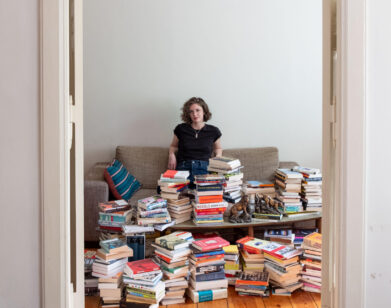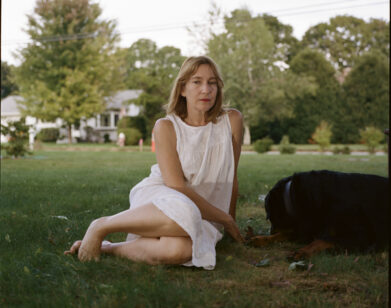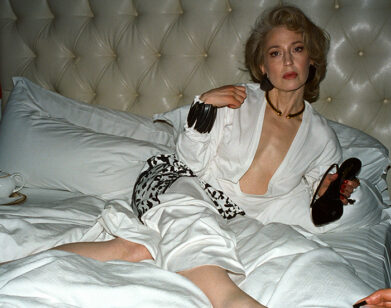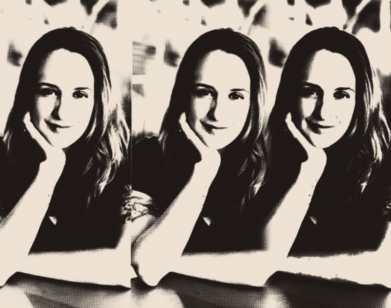literature!
Sheila Heti on Ejaculate, Jewelry, and Life in Toronto
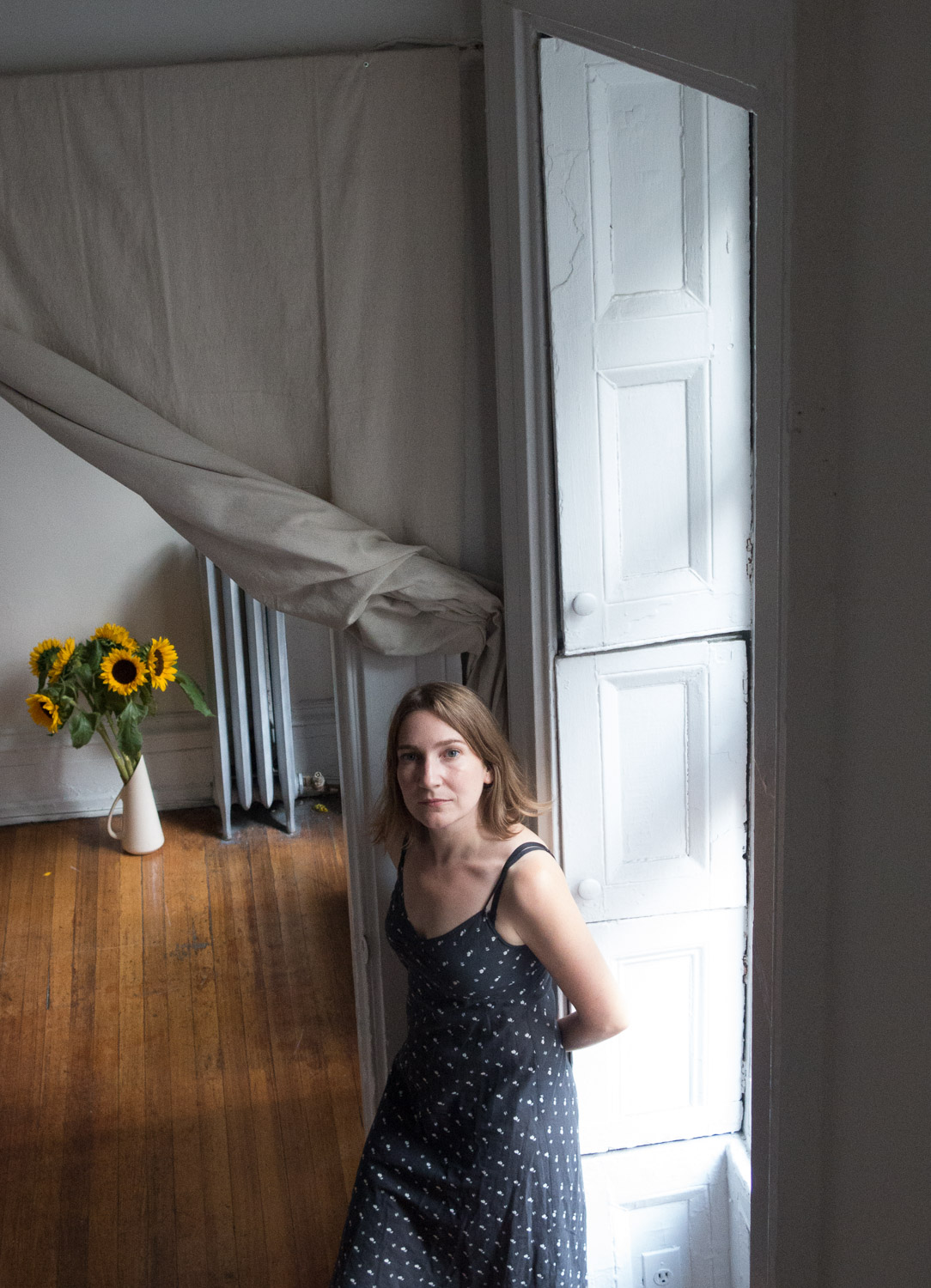
Sheila Heti. Photos by Sylvia Plachy.
Sheila Heti, the novelist, playwright, and critic, approaches the soul as though it were a matter of public consideration. A social activity. A thousand-piece puzzle. Her characters – willful, seeking, funny – compete as though the winner is whoever can find the most meaning, unfazed by the possibility of ordinariness. They’re obsessed with genius, tentative about success, innocent of major experience, determined to dissuade themselves. Mostly, they are modern spiritualists. Her breakout novel How Should a Person Be followed “Sheila” and her friends as they try to figure out how to figure things out; Motherhood treats its titular subject like a truth-or-dare question. Pure Color, her geistic new novel, asks less how should a person be but what can a person be (and when? and with whom?).
The novel separates people into three types: birds (the aesthetes), fish (the collectively minded), and bears (the lovers). Mira, a “birdlike woman” seeking “a difficult life on the knife-edge of feeling,” falls in love with the mysterious Annie, who seems to her a “distant fish.” Things take a psychedelic turn when Mira’s father, a bear, falls ill and dies, transferring his spirit into her. What is the right distance to keep from people? Mira, somehow always too close to and too far from people, doesn’t know. To understand Heti’s relationship to her subject matter, we sat down with the author for a conversation about childhood innocence, finding meaning in loss, and the connection between novels and paintings.
———
JANIQUE VIGIER: Purity is really the thing of the novel There’s the title of course, but also the “pure love and elation” when Mira’s father’s spirit comes into her; his promise to her, as a child, to show her “pure color”; Mira’s “pure desire” for the lamp. Purity here isn’t innocence of experience, but something unalloyed. How did the idea become so central to the book?
SHEILA HETI: I’m finding it really hard to answer questions about this book, because usually when I write a book, I have a very vivid memory of the intellectual struggles of writing that particular book. The experience of writing this one is kind of lost to me now. Usually I remember where I’m sitting when I write something, but with this one, I mostly can’t. The novel is about this kind of otherworldliness, but the experience of writing it also seems to have happened in a slightly different space than usual. So much of it came to me in bursts and it was more like a dream. I guess that purity of love, purity of emotion, or purity of feeling, is what I was experiencing. That’s where I felt my body was in time and space when I was writing the book.
VIGIER: This one felt more internal than the past novels?
HETI: It just felt more like I was just writing it for myself. Really that sort of pure, “I just need to put this down on paper so that it’s documented” impulse. More like taking notes for something you don’t want to forget.
I wasn’t thinking of an audience the way I was with my last two novels. With the last two, I thought, “Okay. This is going to be in the world. This is for people,” but I wasn’t thinking about that with this one.
VIGIER: Motherhood was so much about religion, but with this one it’s like you’re bringing theology back down to earth.
HETI: Oh, that’s nice. I think this book is less Jewish, maybe less part of a religious tradition. In Motherhood I was trying to think about my present conditions or one’s present conditions through that biblical story of Jacob wrestling the angel, whereas with this book I was thinking, “What happens when we have the sense of god but none of the stories to make sense of god?”
VIGIER: You’ve written one children’s book before, and now there’s one coming out soon, right? [A Garden of Creatures is coming out in May from FSG.] How do you think of these in relation to your novels?
HETI: My boyfriend pointed out, “You wrote two children’s books about death.” I didn’t even realize that, but it’s true. They’re both about death. The first one was a commission from McSweeney’s, so that was just a direct effort, whereas this one I just wrote on my phone on the way to clean out my father’s house after he died. I wrote it on my phone, and then I thought, “Is this any good?” Esmé Shapiro, who did the illustrations, and who has written and illustrated other children’s books, made a painting for an editor I knew of her animals. It was Esme’s side job, and so I asked her after my last dog died to make a painting of that dog for my boyfriend for his birthday, and we really loved it. It was such a beautiful painting, and I just thought, “Maybe I’ll send this idea to her and see what she thinks of it,” and she loved it, and she wanted to make a book of it. So that’s how that happened.
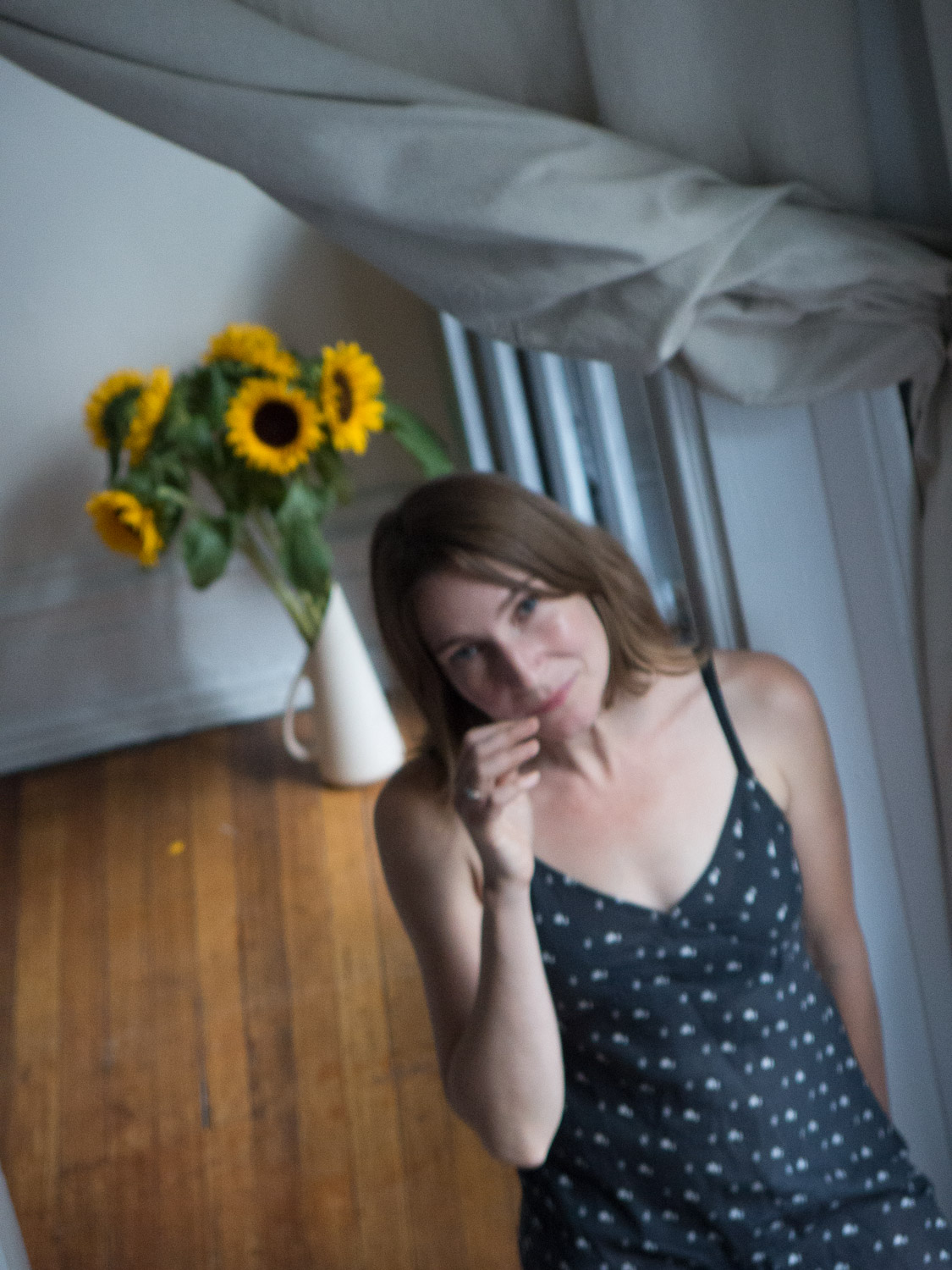
VIGIER: Did you start writing Pure Color after your father’s death?
HETI: No. I started it a year before he passed away. He had already become sick. I had been writing about a critic character based on my friend Christian Lorentzen. The book was pretty different when I started. It was much more about art critics and art criticism. I was thinking about him, and I was thinking about this essay of Ben Kunkel’s about the progress of art history, and so he briefly became a character.
I thought, “Well, maybe I’ll write a book about art criticism,” and I began reading one of my favorite books, Manet and his Critics. It’s a book that I always come back to. That was one of the seeds. The idea of the first and second draft also came very early. I think you’re just always trying to bring all these different ideas together and see, “Which ones can be tied together? How many can you tie together and still feel like it’s all about the same thing at heart?”
VIGIER: Pure Color seems somewhat more ‘novelistic’ than your past work, and by that I just mean more plot-driven.
HETI: With every book I’m teaching myself something different about how to write a novel. I think story is the hardest thing for me because stories can feel so false. Narratives can feel so false, and if I’m going to write a narrative, I want it to feel real—what’s a real narrative? What’s a real story that we live? I’m getting better at it. Narrative is becoming less of a struggle as time goes on.
VIGIER: I love what happens once Mira gets out of the leaf. She’s very open to the world, and there are all these fumbled attempts at connection. The scene where she goes to Annie’s house dressed as a leaf, with her face and body painted, like of course that would alienate someone, but it’s so tender and tragic.
HETI: My friend Misha Glouberman read a draft of the book, and he said, “Oh yeah. You have the most profound experience of your life, and then you try to communicate it to other people, and you just look like a fool.” I kind of love that. I thought, “Oh right. That’s what’s happening there.” It’s so humiliating to be an artist in some ways.
VIGIER: The deepest relationship in the novel is the one between Mira and her father, and it’s very intense. There’s a constant push and pull between them, between their closeness and Mira’s desire to be free of him. When he dies and his spirit enters her, it’s described the universe is “ejaculating his spirit” into her. That’s a….specific word.
HETI: That’s just what it had to be. That was the word for it. I had a couple friends read early drafts, and they were like, “It’s a bit much.” But sometimes the relationship between fathers and daughters is a bit much. I mean, one’s sexuality is part of everything. It’s kind of a taboo thing to talk about. There seems to be something symbolic about ejaculation. It doesn’t only have to be from a penis. There’s something about that word—about the look of it, what it means, the suddenness and explosion of energy—that can go beyond just being a word you use for cum. Why can’t it be a symbol, too? We turn everything that we experience into symbols, and this seems like such a powerful one. I mean, it’s the beginning of life, and maybe it’s the end of life too, in that instance.
VIGIER: [Laughs] I’m going to totally switch gears now. I loved the sections in the book that felt almost like standalone prose pieces, like when Mira is working first in the lamp store and later in the jewelry shop. It reminded me of The Ladies’ Paradise. How did these objects come to have such a big place in the book?
HETI: I hadn’t thought about the connection to that novel, but strangely it’s what I was reading when I was working on the book. I put together the first draft of the book at that MacDowell artist’s residency, and that was the main book I read when I was there. Although now that I think of it, the draft that I put together at MacDowell didn’t have the lamp store in it, and the ring store didn’t come until much later, but I guess it must have gone into me. God, I love that book. What was I saying? The ring stuff, do you know the website 1stDibs?
VIGIER: Love it.
HETI: I became obsessed with looking at rings on this website, and I just couldn’t figure out what was going on with me. I was like, “You’re not going to buy a $24,000 ring, why are you wasting your time? You should be writing,” and I kept saving all these pictures. I was just completely mesmerized by these rings, and I felt very guilty for procrastinating. I kept thinking, “This is the worst consumeristic impulse.” I wrote that passage and realized, “Oh. That’s what that obsession was for, so that I could write this passage and describe these different jewels.” The other day I remembered that Mira plays the jewel game on her phone, and I thought, “Oh. There are jewels there too.” This glittering world.
It’s almost like fairy tales when you were a kid. I remember this copy of Little Red Riding Hood that I had, and in one picture she was carrying jellybeans in a basket, and the jellybeans were just so beautiful, and I was mesmerized by those jellybeans. You don’t have so much of that in adult life, where things are so charged. I remember I had a sticker on my window that was this transparent sticker of a rainbow, and do you remember those black stickers that you would push on and they had gasoline inside, and it would create these rainbows? There was this way that objects were charged when you were a little child, charged with beauty.
VIGIER: I loved those sections, because Mira is described as a bird, and you know how bowerbirds take special glittering objects and construct a nest with them? I imagined Mira as a bowerbird.
HETI: She’s a lover of beauty. I mean, she’s a critic, but she’s not an artist, but she’s drawn to beauty in all these ways. The lamp, the rings.
VIGIER: The other image that stayed with me while reading was Manet’s asparagus painting described in the Critics School. I remember the narrator in How Should a Person Be? standing in front of that painting, and then it appears here, like an inside joke with yourself, or something that comes full circle.
HETI: I think I’d even forgotten that I had written about it in How Should a Person Be? so it wasn’t a joke. I guess it must be my favorite painting, if you can have one. I just find it so moving. If I could have one painting with me here, that would be the one.
VIGIER: It’s incredible.
HETI: Yeah, and he made it as a gift for a patron, right? You know the story about it? I could be wrong, but I think a patron bought his painting called A Bundle of Asparagus, which was a painting of a bunch of asparagus. Then Manet, probably quickly, made this little painting as a thank-you, saying something like, “You forgot one,” and he sent it to him as a gift [A Sprig of Asparagus]. Maybe that’s part of the reason that I like the painting so much. I think art that’s made for a specific person has a certain secret, modest, special quality. He wasn’t making it for a huge audience. He just was making it for one person he felt gratitude towards, and it has that love in it, and it’s not trying to make a case for itself to the world.
VIGIER: You mentioned showing people some drafts of the novel. Do you often share drafts with people while you’re writing?
HETI: I do.
VIGIER: Always the same people? Or does it depend on the book?
HETI: I’d say I shared it with about 40 people as I was writing it, and same with Motherhood. Half are close friends, and maybe 30% are people I’m having a temporary correspondence with, and I sent it to them because they have a specific perspective on it that will be helpful. It seems more and more that, with each book, I feel less bound to rely solely on my own brain.
VIGIER: Less bound. That’s so interesting.
HETI: Yeah, less bound. It all feels pretty seamless, unthreatening, and useful.
VIGIER: Even though it’s your novel, and you’re the author, there’s some collaborative element that feels okay to let in at this point in your life?
HETI: Yeah. It’s for the world ultimately, so it’s helpful to have the world be part of the creation of it. I trust the world, and I trust these readers, I just like people.
VIGIER: When you were younger, you felt you had to prove it was all you.
HETI: I think you’re right. I think it was ego.
VIGIER: You have to have a really strong understanding of yourself to be able to take in other people’s opinions.
HETI: I think that comes with getting older, 10 or 15 years ago, it was much more overwhelming because I didn’t have as solid a core. I receive a lot of feedback along the way that shows me that the book is not good enough. It’s good to be able to take that in without having it hurt your relationship with that person. But if you’re going to be upset at a person because they don’t think your book is ready, or because they don’t like your book, then the whole thing falls apart. There has to be trust. You trust them to tell you the truth, and they also have to trust that they can tell you, “This is not good,” and you’re not going to hate them.
VIGIER: I have this romantic idea of your life, where you have this group of people around you that you’ve been close to for over 20 years. I wanted to ask you about how you felt about staying in Toronto.
HETI: It seemed like the stupidest… For 10 years or more, I would ask myself, “Why aren’t you moving to New York?” Now I think, “Oh my god, that was the best decision, or non-decision I ever made.” That instinct that kept me here…I don’t think that I would have been able to write the books I’ve written if I had lived in New York. I don’t think I would have had the relationships I have now. I’m not saying this as advice for anybody else, I’m reflecting on my own life.
VIGIER: Why is that?
HETI: When I was young, I didn’t know I was the kind of person who would want so much continuity. I had this idea about myself as an adventurous person, and so I would think, “Why am I not off living in another place?” Now I see that I am an adventurous person, but I also value these things that anchor the self. Adventurous doesn’t only mean living in different cities. You can be adventurous in your imagination.
VIGIER: Has living there inflected your work?
HETI: It’s just so quiet in my head here, and I’m patient. When I go to New York, I’m not able to find that patience inside myself. You want to be part of the movement of life, of the energy that’s so compelling and interesting.
VIGIER: The thing New York is that so much of how you see people is about how they choose to be seen. The public persona that they’ve chosen to present.
HETI: Yes, it’s a city on a stage. That’s its beauty too, right? That’s what’s so wonderful and glamorous about cities like that.
VIGIER: It’s entertaining.
HETI: The question is, do you ever make it backstage?


